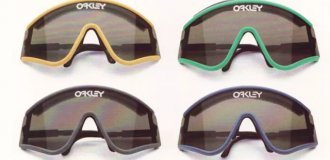Three young gentlemen, sailing on the Thames in the same boat (with a dog) and later made famous by Jerome K. Jerome, forgot to take a can opener on the voyage. And when they wanted to enjoy canned pineapple slices in syrup after breakfast, they tried to open the can with a penknife. But he broke down very quickly, severely injuring one of his friends. Then scissors, a fishing hook, a large sharp stone and even a boat mast were used. From many blows, the bank acquired a “monstrously ugly shape,” but still did not give in, stood firm, and did not allow a hole to be punched in it. Out of anger, her friends drowned her in the Thames.

French cook Nicolas Appert (1749 - 1841) spent almost 15 years developing a way to preserve food. At the same time, he proceeded from the latest scientific theory at that time, according to which food spoils from prolonged contact with air. To remove air from a glass vessel with food, he heated it with steam and, without allowing it to cool, sealed it with a wide stopper, and then filled the stopper with wax. There were no problems with uncorking, but glass jars are too fragile. In 1795, the French government promised a prize to anyone who could develop a method of long-term food storage, which was essential for Napoleon's army. In 1806, confectioner Nicola Appert proposed a conservation technology, for which he received the title “Benefactor of Humanity” from the emperor.

At a canning factory. English engraving from 1870.
It is interesting that the first patent for a can opener appeared only 48 years after, in 1810, shortly after the invention of the canning method by the Frenchman Appert, the Englishman Peter Durand received a patent for a tin can from King George III. Already in 1812, the entrepreneur founded a canning factory in London. A can of green pea stew made at Durand's for the Royal Navy in 1818 was found to be quite fresh when it was opened in 1938. However, opening the first canned food was very difficult. A can of veal roast from 1824 bears the inscription: “Open with a chisel and hammer, cutting around the top cap.” True, we must take into account that the cans were then made from sheet iron up to 5 millimeters thick. The container sometimes weighed more than the contents.

Tin can from 1824. Empty. she weighed almost half a kilogram.

Can opener from 1865, called "bull's head". A very common model that has changed little to this day. Now such a knife from the second half of the 19th century costs collectors at auction about 50 dollars, which is three times more expensive than a brand new modern electric can opener.

Samples of can openers from the mid-19th century.
Cans made of thin steel sheet appeared in the middle of the 19th century, when they learned how to make thin rolled steel. Moreover, at first they were made by hand. A skilled tinsmith managed to make 60 cans per day. It was only in 1846 that the Englishman Henry Evans developed a method for stamping the body of a can with one blow, and 60 cans began to be produced in one hour. Although the lid had to be soldered manually for another half a century. In 1858, Ezra Warner from Connecticut (USA) patented a can opener that had two blades: one cut the lid of the can, the other held the knife on its side. The device looked like a hybrid of a bayonet and a sickle. Other sources name the Englishman Robert Yates as the discoverer of the can opener, who received a patent for his can opener in 1855.
At one time, since not everyone knew how to open a can and not everyone had a can opener at home, the clerk in the store opened each purchased can before handing it to the buyer. Canned food and can openers became widespread ten years later, when canned food manufacturers began to include a free knife with each can. During the American Civil War, northern soldiers received a Warner opener along with their canned food rations. From the 60s until the end of the 19th century, there was an explosion of patents on this topic. In 1866, the American J. Osterhoud patented a tin, the lid of which was screwed onto a special key with a slot, revealing the contents. Sardines are still preserved in these jars. The knife with a cutting wheel was invented by the American William Lyman in 1878.
Its design included a lever with a point that had to be inserted exactly into the center of the lid. Then it was necessary to move the cutting wheel on this lever in accordance with the diameter of the can and move it along the perimeter of the lid, cutting through the tin. The success of the operation depended on how accurately the center of the lid was found. In 1921, a design appeared that was practically no different from the modern one - without a long lever, but with a gear wheel that turns the can towards the cutting wheel. Ten years later, electric can openers were invented.
Miniature can opener R-38 from the mid-20th century.
Some experts consider the most ingenious invention of the 20th century to be the standard P-38 can opener, which was included with dry rations for the American army from 1943 to 1981. The name is deciphered as follows: P - from the word “patent”, 38 - the number of key swings required to open an ordinary can of American army stew. Developed in 30 working days in the summer of 1942 by the Life Support Research Laboratory in Chicago, the key was intended to be disposable but could last for many years. It was made by stamping in a few seconds.

At the tip of this folding device, which consisted of only two parts, a pressure of several tons per square millimeter develops during operation. The hole was intended to be used to thread a string through the key after each use and lower it into boiling water on a string - any remaining food on the knife must be sterilized, otherwise it will rot and there will be a risk of food poisoning next time.


A folding knife with a bottle opener key and a can opener (below) are domestic analogues of the R-38 knife.


Domestic can opener, analogue of the "bull's head".

Domestic can opener with cutting blade and bottle opener. Very easy to use thanks to the lever handle. The photo below shows this knife in action.


Domestic can opener with cutting blade

This can opener, which has never been sharpened, is almost half a century old. But to this day it perfectly opens any can, doing the job better than a bull's head knife.

This knife can be used to open bottles and pierce a hole in the lid of a can.

Professional waiters use a sommelier knife to open bottles of wine. The corkscrew is screwed into the cork, the stop (the left figurative part in the photo) is placed against the neck of the bottle and, by pulling the lever towards you, the cork is pulled out.



Swiss can opener with cutting wheel. 70-80s of the XX century.


A modern model of a Spanish can opener.
This item is clearly not mass produced. On one end is a bull's head can opener, on the other, in a heel, is a bottle opener.

A modern electric can opener opens a magnetically held can in a matter of seconds. After opening, the lid remains on the magnet, but the jar does not fall, since its edge is tightly clamped between the knife blade and the gear wheel. This device is very convenient when you have to open a large number of cans.

In 1959, in Ohio (USA), the scene described by Jerome was almost exactly repeated. A certain E. Fraze went on a picnic, took canned beer with him (pouring beer into cans began in 1934), but forgot the can opener! He eventually managed to open the can on the sharp edge of his car's bumper. Returning home, he invented the beer can with a pull-tab lid, and since 1963, beer has been bottled only in cans that don't require a can opener.























